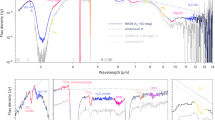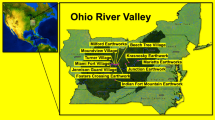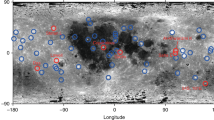Abstract
THE recovery of thousands of meteorites in the Antarctic since 1969 has not only greatly increased knowledge of the meteorites themselves but has also provided a new tool for glaciology. Most Antarctic meteorites are found on blue ice areas where old ice is continuously ablated. A measurement of the age of this ice helps us understand meteorite accumulation mechanisms and the dynamics of ice movement. The terrestrial age of a meteorite, the time period since the date of meteorite fall, can be determined from the reduction in concentration of cosmogenic radionuclides during the time the meteorite has been shielded by the Earth's atmosphere. Here we report the terrestrial age of a meteorite that was recovered from below the surface of the ice and argue that this represents a measurement of the age of the ice itself. We measured the cosmogenic radionuclides 10Be (half-life = 1.5 Myr), 14C (5,730 yr), 26A1 (0.71 Myr), 36C1 (0.30 Myr) and 53Mn (3.7 Myr) in the meteorite and 10Be and 36C1 in the ice. We obtained a terrestrial age of 11,000 years for the meteorite which suggests that the snow accumulation area where it fell was only a few tens of kilometres away.
This is a preview of subscription content, access via your institution
Access options
Subscribe to this journal
Receive 51 print issues and online access
$199.00 per year
only $3.90 per issue
Buy this article
- Purchase on Springer Link
- Instant access to full article PDF
Prices may be subject to local taxes which are calculated during checkout
Similar content being viewed by others
References
Fireman, E. L. Antarct. J. U.S.A. XXII, 75–77 (1987).
Nagata, T. Mem. Natn. Inst. Polar Res., Spec. Iss. No. 8, 70–92 (1978).
Nichio, F. & Annexstad, J. O. Mem. Natn. Inst Polar Res., Spec. Iss. No. 17, 1–13 (1980).
Whillans, I. M. & Cassidy, W. A. Science 222, 55–57 (1983).
Gow, A. J. & Cassidy, W. C. Smithson. Contr. Earth Sci. 28, 87–91 (1989).
Suter, M. et al. IEEE Trans. Nucl. Sci. NS-30 1528–1531 (1983).
Jull, A. J. T., Donahue, D. J. & Linick, T. W. Geochim. cosmochim. Acta (in the press).
Elmore, D. et al. Nature 277, 22–25 (1979); and erratum, Nature 277, 246 (1979).
Drewry, D. J. Nature 287, 214–216 (1980).
Nishiizumi, K., Elmore, D. & Kubik, P. W. Earth planet. Sci. Lett. (in the press).
Fireman, E. L. Antarct. J. U.S. (in the press).
Jull, A. J. T., Donahue, D. J. & Linick, T. W. abstr. Lunar Planet. Sci. XX, 488–489 (1989).
Raisbeck, G. M. et al. Nature 292, 825–826 (1981).
Beer, J. et al. Radiocarbon 25, 269–278 (1983).
Evans, J. C. & Reeves, J. H. Earth planet. Sci. Lett. 82, 223–230 (1987).
Author information
Authors and Affiliations
Rights and permissions
About this article
Cite this article
Nishiizumi, K., Jull, A., Bonani, G. et al. Age of Allan Hills 82102, a meteorite found inside the ice. Nature 340, 550–552 (1989). https://doi.org/10.1038/340550a0
Received:
Accepted:
Issue Date:
DOI: https://doi.org/10.1038/340550a0
Comments
By submitting a comment you agree to abide by our Terms and Community Guidelines. If you find something abusive or that does not comply with our terms or guidelines please flag it as inappropriate.



